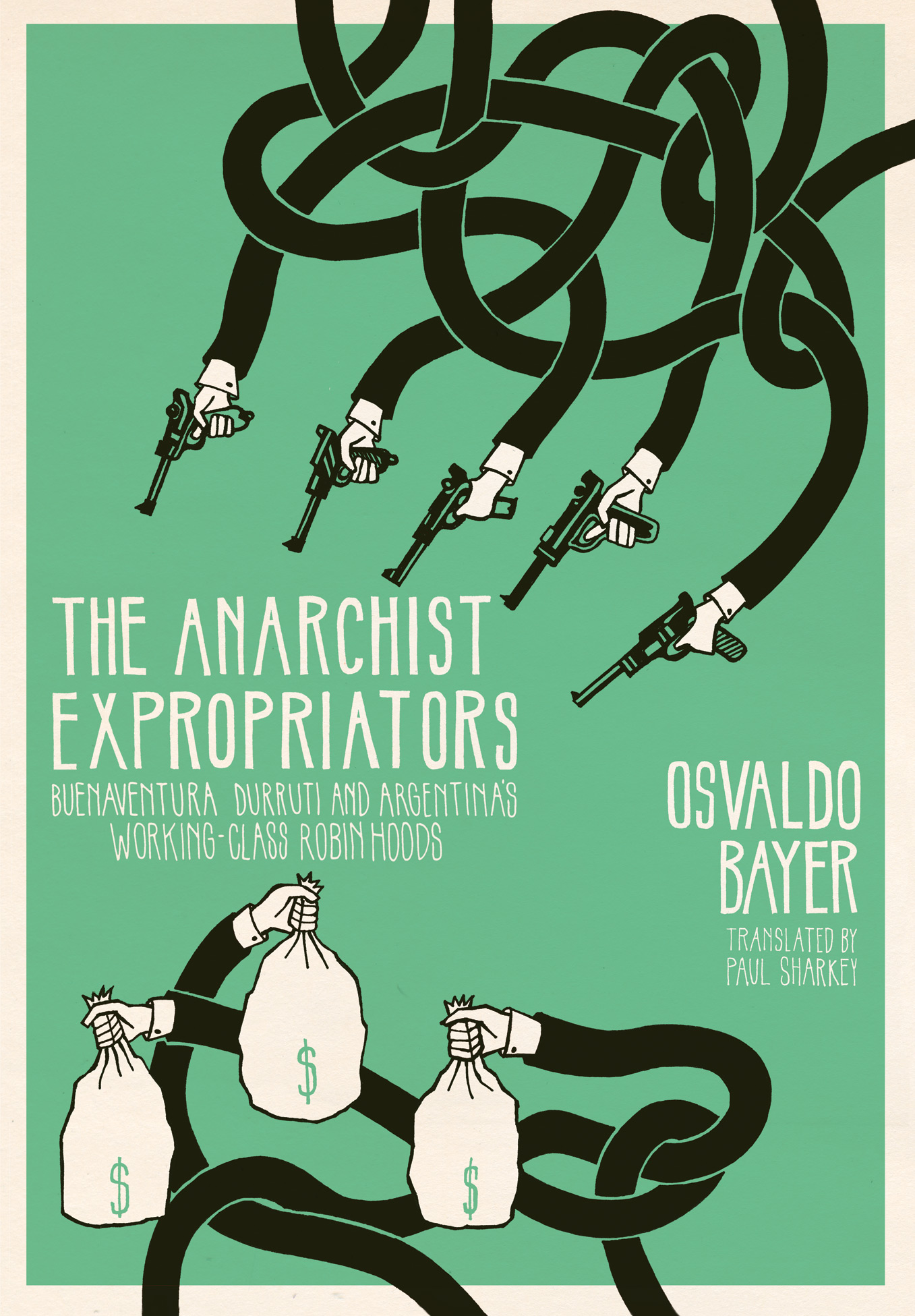Introduction
Its a chastening thought that Osvaldo Bayer wrote this book nearly forty years ago and his work still challenges us, as anarchists, with ideas, arguments, and problems that are still as relevant today as they were in 1975 or, indeed, as when the actions of this narrative were originally carried out.
Much of Bayers work belongs to the first wave of modern anarchist historiography that was, and still is, concerned with excavating anarchisms stories; research that began to challenge our ideas as to what anarchism is and had been. Some of those early pioneering works include those by James J. Martin (1953) and Voline (first English translations in 1954 and 1955) as well as the works of Antonio Tellez (1974 in English), Bill Fishman (1975), Hal Sears (1977), and Paul Avrich (1978). These authors, together with Bayer and others, made the 1970s an exciting time for anarchist research. The Anarchist Expropriators was first published in 1975 as Los Anarquistas Expropriados y otros ensyos and is here published in its first English translation. It appeared shortly after what we consider to be Bayers greatest work, the four volume La Patagonia Rebelde (19721975), soon to be published in one volume as Rebellion in Patagonia by AK Press. A later work, Simon Radowitzky and the Peoples Justice (1991), was recently published by Elephant Editions. Bayer and some of the other writers mentioned here were lucky enough to know some of the relatives and comrades of those who feature in their work, and this knowledge informs their narratives with a richness and immediacy that later histories often lack.
The Anarchist Expropriators is a companion piece to Bayers earlier work Severino Di Giovanni idealists de la violencia (1970), which was translated into English as Anarchism and Violence by Elephant Editions in 1985. The main protagonist of that work, Severino Di Giovanni, is glimpsed only occasionally in this volume, which in essence concentrates on other groups of anarchists carrying out acts of expropriation and revenge both alongside Di Giovanni and his comrades and after Di Giovannis execution on February 1, 1931. It presents us with additional information on the Argentinian anarchist expropriation movement that peaked during the twenties and thirties. Vicious infighting between anarchists, ruthless state opposition, bad luck, and its own ineptness destroyed this complex, challenging, and provocative movement, and Bayer attempts to show how that happened. Like Anarchism and Violence , the book is short on analysis but long on action. Events hurtle along at breathtaking speed and, by the final page, we are left breathless (and a little confused as to what has just happened!).
It is best not to read this book as a portrayal of the romantic outsiders who cannot fit into society and take a principled stand against all the everyday hypocrisies they see in anarchists and the rest of the worldthe Stirnerite individualists going out guns blazing, proudly proclaiming their identity in a world that constantly attempts to suffocate them. Undoubtedly there are traces of that, but the people here are a little different from Di Giovanni and others who featured in Bayers earlier work. You wont find in these pages the heightened language, the passionate hyperbole, the tragic hero set against the world. Men such as Miguel Arcangel Roscigna and Juan Antonio Moran seem much more hardheaded and pragmatic. In different circumstances, they could have been the 1936 version of Durruti who survived his own expropriation career and, during the period covered by this volume, was no different from these men. Indeed Durruti thought so highly of Roscigna and his activities that he wanted him to come to Spain and help with the anarchist struggle there.
Argentinian anarchism in the twenties and thirties was a product of brutal state repression against a movement that, in the early part of the twentieth century, was a force to be reckoned with. This repression, exemplified by the events of 1 st May 1909, the Social Defense Law of 1910, and the Tragic Week of 1919, together with a constant, brutal day-to-day treatment at the hands of the police and other agencies, reflected the concern anarchism engendered in the authorities. Reacting to these and other factors, such as the popularity of syndicalism among the working class, some anarchists began to analyze and reflect on what they believed and where they thought these beliefs should take the movement. Spurred on by the events of the Russian revolution, writers such as Lopez Arango and Abad de Santillan, for instance, were teasing out the relationship between syndicalism and anarchism in the labor movement, discussing the nature of trade unions, and the intricacies of class as the lodestar of anarchism as they attempted to rebuild a movement that would bring about the world they desired. The primary vehicle for this discussion was La Protesta , the paper they edited.
All this is well and good, but there were still profound differences in the movement and, as is so often the case, this slice of anarchist history reverberates with internecine quarrelsquarrels that became bitter and bloody but, in themselves, are reminiscent of similar quarrels in other countries and at other times. In essence, they revolved around those constant and exhausting questions of what anarchism is and the best way to practice it and bring about anarchy. Bayer is careful to try to delineate the complexities of these differences and provides us with a useful guide to understanding them.
But there is still a little more that we may need to consider. Personality clashes and questions of ownership of resources had a deleterious effect on theory and practice. The execution of one of La Protesta s editors, Lopez Arango, probably by Di Giovanni, in October 1929 is chilling. This though was not the first time that violence had occurred within Argentinian anarchism. We should remember that, in August 1924, gunmen from La Protesta raided the anarchist paper Pampa Libre leaving one dead and three wounded. These were not simply intellectual and practical differences between comrades, but ones that were visceral, deeply felt, and with deadly consequences. Such tensions brought about some kind of fractured dialectic between the realities of the world outside the movement and the antagonisms within it. The results were not edifying.
Understanding the development of these tensions is not easy from this distance. One senses that much of the antagonism on the part of those around La Antorcha (presented in this volume as essentially La Protesta s most constant critic) who had broken away from La Protesta in 1921, consisted of a number of factors. A major concern was the printing press and resources that La Protesta owned: who gave the present editors the right to own them and why werent these resources shared across the movement? Secondly, and just as importantly, was the fact that La Protesta saw itself as THE paper of the Argentinian anarchist movement (with the backing of the FORA) while La Antorcha saw itself as ONE of the papers of a much more diverse anarchist movement than the one with which those around La Protesta identified. The editors of La Antorcha certainly did not offer whole-hearted support to the expropriators, but it did support expropriator anarchists who were imprisoned (unlike La Protesta who saw them as anarcho-bandits). It also condemned La Protesta s habit of naming or slandering those who had committed expropriations ( La Protesta , for instance, described Di Giovanni as a fascist agent), calling the editors police informers. Hence the question of violence may not have been quite as central as Bayer suggests in driving the antagonism between the two papers. All this, remember, occurred between groups of people, many of whom had worked together in previous years, and indeed would in future ones.









